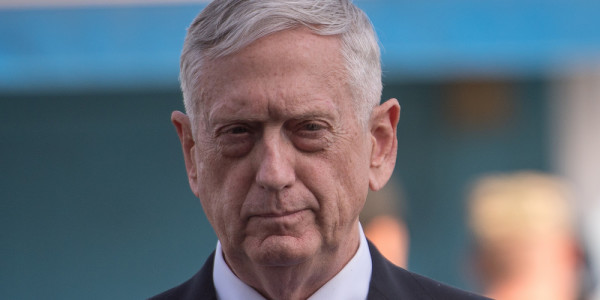

Secretary of Defense James Mattis ostensibly traveled to South Korea to lay the groundwork President Donald Trump’s upcoming first official visit to Asia: “Our goal is not war,” the Pentagon chief told reporters on Oct. 27. But everything about his visit to the demilitarized zone separating North Korea from South came with a less-than subtle subtext: Don’t fuck with me.
“We’re doing everything we can to solve this diplomatically — everything we can,” Mattis said after descending from a Black Hawk helicopter at Panmunjom, the “truce village” where the uneasy ceasefire between North and South Korea was finalized in July 1953. The U.S. goal, said Mattis, isn’t armed conflict, “but rather the complete, verifiable and irreversible denuclearization of the Korean Peninsula.”
But Mattis’ trip to the 38th parallel seems to say otherwise: Just look at these photos of the former Marine general staring down North Korean border guards after declaring the regime in Pyongyang an “oppressive regime that shackles its people, denying their freedom, their welfare and their human dignity.”

Mattis: “I could kill you right now and nobody would suspect a thing.”Photo via DoD

Nothing fancy, just Mattis doing 3/4 of a perfect parade rest while casually conversing with a U.S. Forces-Korea staff officerPhoto via DoD

Mattis: “That’s a subpar knife hand, but I’ll allow it.”Photo via DoD

The face of doom.
Diplomacy, Mattis told reporters on Oct. 25, needs a credible threat of force behind it. “Ultimately, our diplomats have to be backed up by strong soldiers and sailors, airmen and Marines, so they speak from a position of strength, of combined strength, of alliance strength, shoulder to shoulder,” he said, adding that North Korea’s “provocations continue to threaten regional and global security.”
Mattis’ comments cap off weeks of slow, steady military build-up as tensions between the U.S. and North Korea once again soar.
On Oct. 25, the Navy announced the retasking of the USS Nimitz aircraft carrier to the Korean peninsula after completing its mission as part of Operation Inherent Resolve against ISIS in Iraq and Syria in the Middle East. That means that three U.S. carrier groups will be operating in the Pacific for the first time in more than a decade. On Oct. 23, the Air Force announced it would deploy a dozen brand-new F35A fighters to Okinawa in “early November,” a move “designed to demonstrate the continuing U.S. commitment to stability and security in the region,” the branch said. And On Oct. 16, the nuclear submarine USS Michigan stopped off in the South Korean city of Busan for a “routine port visit,” outfitted with two silos for SEAL Delivery Vehicles — and raising the spectre of a “decapitation strike” that’s had Kim Jong Un shaking in his boots for months.
Related: Mattis To Military: ‘Be Ready’ For What Trump Decides To Do About North Korea »
It’s not just U.S. Pacific Command rattling its sabers. On Oct. 19, South Korean officials unveiled a brand new, three-layer attack strategy based around — I shit you not — a surface-to-surface “Frankenmissile” that’s “powerful enough to destroy North Korea’s underground military facilities and command center,” according to the Korean Herald.
The “three tier missile attack plan,” as The War Zone succinctly described it on Oct. 26, is “to present North Korea with the threat of rapidly losing much of its ballistic missiles, nuclear weapons, and long-range artillery capabilities, which the South Korean Army said would be ‘unbearable costs’ for Kim Jong-un’s regime.”
Those reports capture South Korea’s significant reinvestment in its own defensive and first-strike capabilities, beyond the protective resources the of U.S. military in the region. Even a U.S. surgical strike on North Korean command-and-control facilities (or a “decapitation” strike against regime leadership) could likely trigger retaliatory artillery strikes from the North, causing potentially thousands of daily casualties in the South. Officials in Seoul are clearly planning to prevent that. “We would use those three types of missiles as the first salvo of the missile strike and concentrate them during the initial phase of war to destroy North Korea’s long-range artillery units and missiles located in ballistic missile operating area,” Korean Army officials wrote, per The Korea Herald.
All of this is, well, pretty sweet. Let’s just hope PACOM doesn’t decide to call in Mike Pence for reinforcements.
WATCH NEXT:
